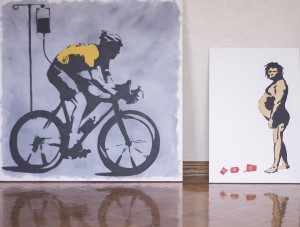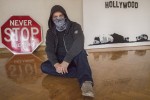A sign in Beverly Hills read“Stop making stupid people famous.”
A makeshift grave marked victims of gun violence on Melrose Ave.
A “Useless Plastic Box” was priced at $99.99 inside a Sherman Oaks Best Buy.
These are just a few examples of the artist’s illegal street art that could be seen scattered throughout the Los Angeles area. The artist responsible for these pieces is known by the alias Plastic Jesus.
His work will be shown at the Kerckhoff Art Gallery from now until Feb. 1 as part of the Cultural Affairs Commission’s Art Series. The exhibit will consist mainly of acrylic spray stencil works on canvas, which were initially displayed in the streets over the last two years.
Plastic Jesus is a Los Angeles-based artist whose artwork is inspired by popular culture, politics and the news. Plastic Jesus creates art with the intention of encouraging viewers to question the society that they are a part of.
“I make pieces which I install on the street,” Plastic Jesus said. “The idea is to make people stop and think about various issues in society right now, for example drug use, gun crime and chemicals put in food.”
With a background in photojournalism, Plastic Jesus said he first delved into street art when many of the issues he felt strongly about often went ignored by the very media publications he worked for. This frustration lead him to realize that the best way to get his message across was by putting his art out on the streets.

Edwin Zhao, a third-year microbiology, immunology and molecular genetics student and staff member for the Cultural Affairs Commission, is the curator of the exhibition.
Zhao first came across Plastic Jesus’ work while browsing online for possible artwork to feature in the art series, stumbling upon “War Child,” a stencil piece depicting a child soldier holding a teddy bear in one hand and an assault rifle in the other.
“’War Child’ was the first piece that I saw that really stood out to me,” Zhao said. “I feel like a lot of his artwork stands for what cultural affairs is about … educating through the medium of art.”
Zhao said the average UCLA student will serve as a good audience for the messages Plastic Jesus brings awareness to, because a lot of the students are not as conscious of some of the problems facing the greater Los Angles area as they should be, such as the often ignored issue of homeless youth.
The topic of homelessness has been a repeated message throughout a few of Plastic Jesus’ artworks, including two stencil pieces that are featured in the exhibition: “Broken Dreams” depicts ahomeless man and his dog sleeping under the Hollywood sign, and “Dream on Little Dreamer” shows a young child curled up at the bottom of a wall clutching his stuffed animal.
“I recently found out that there are so many children every night that are homeless in Los Angeles,” Plastic Jesus said. “Some of them sleep on the street, some of them are in hostels and some of them are sofa surfing … which I think is a horrific indictment of the country and the city.”
Kylie Carrigan, a fifth-year art and psychology student and the Cultural Affairs Commission’s Art Series director, said another issue featured in Plastic Jesus’ art is societies’ focus on money culture and commodities.
“The piece that really sold me on putting him in the gallery is this giant mouse trap that is as big as a car, but where the cheese would go, there is a stack of credit cards,” Carrigan said. “It’s making a statement about how we all value money …which I definitely think is a hot topic with students right now, with the tuition increases.”
Although Plastic Jesus’ work is being hung in Kerckhoff Art Gallery, street art, as a channel of expression, remains illegal. Because of this, Plastic Jesus has had to take the precaution of protecting his identity to prevent arrest.
“One thing that really irritates me when you drive around Los Angeles is that you notice thousands and thousands of enormous billboard adverts, selling you cosmetics, cars, liquor, thrusted in our face,” Plastic Jesus said. “How can somebody be arrested for putting up a piece of street art that conveys a message of peace, of love, of hope, yet you’re going to have a 45-foot billboard selling alcohol.”
Although the illegal nature of putting art on the street causes Plastic Jesus to conceal his identity from the public, he hopes the accessibility of his art will allow them to know his views on society.
“I think the messages apply to everyone from all walks of life,” Plastic Jesus said. “We all have the ability or the possibility to change society, change culture, change the way people think.”

Plastic Jesus is a great artist! He recently executed a street piece “I Want to be a celebrity” and his “American Excess” installation in London, just in front of Harrods! See pictures here: http://bit.ly/16OE2a9